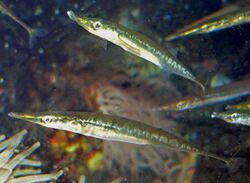Biology:Aulorhynchidae
| Aulorhynchidae | |
|---|---|

| |
| Tube-snout (Aulorhynchus flavidus) | |
| Scientific classification | |
| Domain: | Eukaryota |
| Kingdom: | Animalia |
| Phylum: | Chordata |
| Class: | Actinopterygii |
| Order: | Scorpaeniformes |
| Suborder: | Gasterosteoidei |
| Family: | Aulorhynchidae Gill, 1861[1] |
| Genera | |
|
see text | |
Aulorhynchidae, the tube-snouts, is a small family of marine ray-finned fishes belonging to the suborder Gasterosteoidei in the order Scorpaeniformes. These fishes are found in the northern Pacific Ocean.
Taxonomy
Aulorhynchidae was first proposed as a family in 1861 by the American zoologist Theodore Gill,[1] when he described Aulorhynchus flavidus, placing it in a new monotypic family.[2] This family is included in the suborder Gasterosteoidei of the order Scorpaeniformes in the 5th edition of Fishes of the World.[3] Other authorities treat the Gasterosteoidei as the infraorder Gasterosteales within the suborder Cottoidei or as a sister clade to the Zoarcales in the order Zoarciformes.[4] Some authorities include the genus Aulichthys in the Hypoptychidae,[5][6] but the 5th edition of Fishes of the World puts this taxon in the family Aulorhynchidae.[3]
Etymology
Aulorhynchidae is derived from its type genus, Aulorhynchus, the name of which is a combination of aulos, meaning "flute", and rhynchus, which means "snout", a reference to the flexible tubular snout of the tube-snout.[7]
Genera and species
Aulorhynchidae includes two monospecific genera, i.e. the family comprises 2 species:[3]
- Aulichthys Brevoort 1862
- Aulichthys japonicus Brevoort, 1862 (Tubenose)
- Aulorhynchus Gill, 1861
- Aulorhynchus flavidus Gill, 1861 (Tube-snout)
Characteristics
Aulorhyncidae tubesnouts are characterised by looking like elongated sticklebacks as they have long, slender bodies and have a series of 15 small spines to the front of the dorsal fin. Like related taxa these fishes produce an adhesive substance in their kidneys which they use to create egg masses which are then attached to kelp in Aulorhynchus and inside ascidians in Aulichthys.[8]
Distribution
Aulorhyncidae tubesnouts are found in the northern Pacific Ocean, Aulorhynchus from Alaska to California and Aulichthys from the north western Pacific Ocean.[3]
References
- ↑ 1.0 1.1 Richard van der Laan; William N. Eschmeyer; Ronald Fricke (2014). "Family-group names of Recent fishes". Zootaxa 3882 (2): 001–230. doi:10.11646/zootaxa.3882.1.1. PMID 25543675. https://www.researchgate.net/publication/268078514.
- ↑ Theodore N. Gill (1861). "On a New Typs of Aulostomatoids, Found in Washington Territory". Proceedings of the Academy of Natural Sciences of Philadelphia 13: 169–170. https://www.jstor.org/stable/4059552.
- ↑ 3.0 3.1 3.2 3.3 J. S. Nelson; T. C. Grande; M. V. H. Wilson (2016). Fishes of the World (5th ed.). Wiley. pp. 467–495. ISBN 978-1-118-34233-6. https://sites.google.com/site/fotw5th/. Retrieved 2022-11-25.
- ↑ Ricardo Betancur-R; Edward O. Wiley; Gloria Arratia et al. (2017). "Phylogenetic classification of bony fishes". BMC Evolutionary Biology 17 (162): 162. doi:10.1186/s12862-017-0958-3. PMID 28683774. Bibcode: 2017BMCEE..17..162B.
- ↑ Eschmeyer, William N.; Fricke, Ron; van der Laan, Richard, eds. "Species in the genus Aulichthys". California Academy of Sciences. http://researcharchive.calacademy.org/research/ichthyology/catalog/fishcatget.asp?tbl=species&genus=Aulichthys.
- ↑ Froese, Rainer, and Daniel Pauly, eds. (2022). "Hypoptychidae" in FishBase. June 2022 version.
- ↑ Christopher Scharpf; Kenneth J. Lazara, eds (3 August 2021). "Order Perciformes Suborder Cottoidea: Infraorder Gasterosteales: Families: Hypoptychidae, Aulorhynchidae and Gasterosteidae". The ETYFish Project Fish Name Etymology Database. Christopher Scharpf and Kenneth J. Lazara. http://etyfish.org/perciformes16/.
- ↑ Orr, J.W.; Pietsch, T.W. (1998). "Pipefishes & their allies". in Paxton, J.R.. Encyclopedia of Fishes (2 ed.). San Diego: Academic Press. pp. 172. ISBN 0-12-547665-5.
Wikidata ☰ Q5658608 entry
 |

